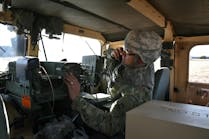By John Rhea
WASHINGTON - Officials of the Department of Defense (DOD) Armed Forces Radio and Television Service (AFRTS) are joining the Pentagon`s push to digitization by upgrading their global distribution network using technology originally developed for commercial broadcasters.
The new system, being installed by Scientific-Atlanta Inc. of Norcross, Ga., replaces a 12-year-old analog system able to carry only a single TV channel and four radio signals. AFRTS distributes news and entertainment programming via satellite to U.S. military ships and installations around the world.
With commercial off-the-shelf (COTS) digital technology, AFRTS leaders expect to provide six TV signals, six stereo radio signals, two monophonic radio signals, utility data circuits, and a T-1 circuit for data file transfers - all within the 36 MHz of bandwidth that has carried one TV and four radio signals. AFRTS uses transponders on the GE SATCOM SN2, INTELSAT 707 (Atlantic) and 702 (Pacific) and EUTELSAT II F2 satellites.
Scientific-Atlanta engineers, working under a $5.5 million contract, began installing four digital compression systems last fall at March Air Reserve Base in Riverside, Calif., and at other military sites at Brewster, Wash., Whitinsville, Mass., and Usingen, Germany.
Programs originate at March and broadcast to the other three sites, where they are uplinked to satellite for distribution. The work should be finished by this summer, says Paul Kosac, vice president for sales in Scientific-Atlanta`s Satellite TV Networks Division.
Like the rest of the DOD, AFRTS officials will use their new digital distribution capability to transfer data as well as radio and television programs. One of the data circuits will be for communications within the organization, and the other, a T-1 circuit, will transfer the contents of the military newspaper Stars & Stripes electronically, so it can be printed locally for quick delivery.
The new system, known as PowerVu, replaces an earlier analog version also from Scientific-Atlanta and known as B-MAC.
The company`s contract contains options for additional equipment in the future, and one area of interest to AFRTS officials is serving the U.S. Navy.
"If the Navy obtains the funding, we can use the PowerVu system to deliver TV to its ships at sea," notes AFRTS director Melvin Russell. "The plan calls for two television channels, two stereo music channels, a monophonic news and sports radio service, and a data circuit to a newspaper for ship on-board printing."
The PowerVu system from Scientific Atlanta replaces an earlier analog system, and will yield the capability to transfer data as well as radio and television programs.


